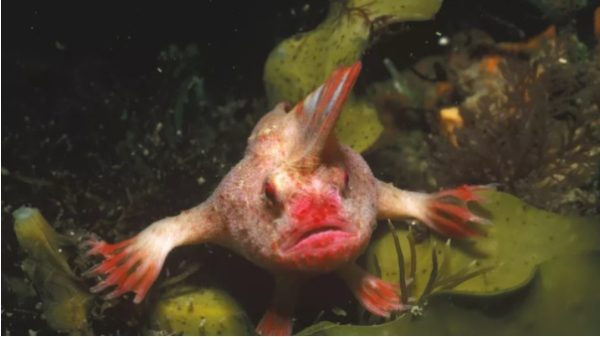今回ご紹介するのは、ちょっと前の記事。
タスマニアに生息していたSmooth Handfish (Sympterichthys unipennis)という魚。
「生息していた」と過去形で表現したのは、実は最近、絶滅になってしまったとのことです。
記録的には200年前に一度発見されてから、それ以後、発見されずにそのまま『絶滅した』と定義されてしまいました。
一度、生体として学術的に記録されてから、初めて「絶滅した」と定義された最初の海水魚になります。

(写真はSmooth Handfishの親類のRed Handfish)
=========================
RIP, smooth handfish. You were weird, and now you’re extinct.
An unusual-looking fish with bulging eyes, a mohawk-like fin on its head and the ability to walk on the seafloor with its pectoral and pelvic fins has reached a grim milestone. The so-called smooth handfish (Sympterichthys unipennis) has been declared extinct, the first modern marine fish on record to completely vanish, according to the International Union for Conservation of Nature (IUCN).
A mere 200 years ago, the smooth handfish was so plentiful in Australia — where it basked in Tasmania’s warm, coastal waters — that it was among the first fish species to be scientifically documented Down Under. In 1802, French naturalist François Péron nabbed the first specimen of the odd-looking creature with a dip net in southeastern Tasmania, a feat that worked because handfish live in shallow waters, the IUCN said in a statement.
Now, Péron’s specimen (which you can see here) is the only smooth handfish scientists have left to study. It’s not that researchers haven’t been looking. Despite extensive underwater surveys along the Australian coastline, the smooth handfish hasn’t “been sighted for over 200 years,” meaning that Péron was the only scientist on record to collect one, according to a 2017 study in the journal Biological Conservation.
With the extinction of the smooth handfish, just 13 other handfish species remain alive. All of the fish live on the seafloor, where they use hand-like fins to “walk.” These fish are now so rare, conservationists gleefully announced to the world that they had found a previously unknown population of the red handfish (Thymichthys politus) consisting of between 20 and 40 individuals in 2018, Live Science previously reported.
Handfish are anglerfish, meaning they’re relatives of the deep-sea anglerfish, the toothy beast that has a luminous bulb dangling from its head, according to Scientific American. Though “walking” fish don’t sport a glowing light, they do have another cool trick that awes scientists: Their babies don’t have a larval stage. Instead, handfish give birth on the seafloor to fully formed juveniles, according to Fauna & Flora International (FFI), a conservation organization based in the U.K.
Moreover, the handfish are homebodies; they don’t have a big habitat. In other words, if their areas are disturbed, the handfish have nowhere else to go.
“They spend most of their time sitting on the seabed, with an occasional flap for a few meters if they’re disturbed,” Graham Edgar, a marine ecologist at the University of Tasmania, told Scientific American. “As they lack a larval stage, they are unable to disperse to new locations — and consequently, handfish populations are very localized and vulnerable to threats.”
=========================
さようなら、Smooth Handfish。あなたは気持ち悪い生き物でした、そして今は絶滅してしまいました。
目が膨らみ、頭にモヒカンのようなひれがあり、胸びれと骨盤のひれが付いた海底を歩く能力を備えた珍しい魚は、厳しい出来事になってしまいました。国際自然保護連合(IUCN)によると、Smooth Handfish(Sympterichthys unipennis)は絶滅したと宣言され、これは記録上最初に完全に消滅した現代の海水魚です。
わずか200年前、タスマニアからの暖かい海水の影響でオーストラリアではSmooth Handfishが非常に多く、ダウンアンダーという雑誌(本)で科学的に記録された最初の魚種の1つでした。 IUCNは声明のなかで、1802年、フランスの博物学者フランソワペロンがタスマニア南東部のディップネットで奇妙な生き物の最初の標本を捕まえました。これはHanfishが浅瀬に住んでいるためにおこった偉業です。
現在、ペロンの標本は、Smooth Handfishを科学者が研究するために残した唯一のものです。研究者が探していなかったわけではありません。オーストラリアの海岸線に沿った大規模な水中調査にもかかわらず、Smooth Handfishは「200年以上目撃されていない」ため、ジャーナルBiological Conservationの2017年の調査によると、ペロンは記録上唯一の科学者でした。
Smooth Handfishの絶滅により、他の13種のHandfishだけが生き残っています。すべての魚は海底に生息し、手のようなひれを使って「歩く」。これらの魚は今では非常にまれであり、保護活動家は喜んで世界に発表したので、2018年に20〜40個体からなるこれまで知られていなかったRed Handfish(Thymichthys politus)の個体群を発見したとLive Scienceは以前に報告しました。
Scientific Americanによると、Handfishはアンコウの仲間であり、頭から電球がぶら下がっている歯の生えた獣であるチョウチンアンコウの親戚です。 「歩く」魚は光を放ちませんが、科学者を驚かせる他の特徴があります。それは、Handfishの赤ちゃんには幼生の段階がありません。代わりに、英国に本拠を置く保護団体であるFauna&Flora International(FFI)によると、Handfishは海底で完全に形成された幼体を産みます。
さらに、Handfishは大きな生息地を持っていません。言い換えれば、彼らの地域が乱された場合、Handfishは他に行くところがありません。
タスマニア大学の海洋生態学者であるGraham Edgar氏は、サイエンティフィック・アメリカンに、「彼らはほとんどの時間を海底に座って過ごし、襲われそうな場合は数メートルしか泳がない」と語ります。 「幼生期がないため、新しい場所に移動することができません。その結果、Handfishの個体数は非常に局所化され、脅威に対して脆弱なのです。」
=========================
参考文献(HP)
https://www.livescience.com/handfish-extinct.html?fbclid=IwAR2fwFqUHEG_ktAvlpKX1aORrvVGUdjWm0Ig7-yqY7sPe8E5A0M9WjPUhDk

